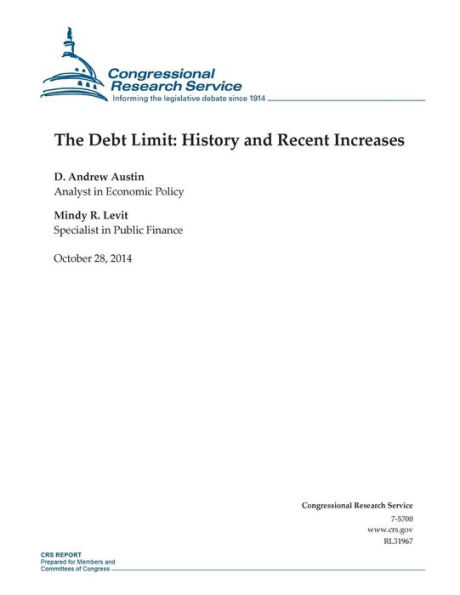Home
The Debt Limit: History and Recent Increases
Loading Inventory...
Barnes and Noble
The Debt Limit: History and Recent Increases
Current price: $19.95


Barnes and Noble
The Debt Limit: History and Recent Increases
Current price: $19.95
Loading Inventory...
Size: OS
*Product Information may vary - to confirm product availability, pricing, and additional information please contact Barnes and Noble
Congress has always restricted federal debt. The Second Liberty Bond Act of 1917 included an aggregate limit on federal debt as well as limits on specific debt issues. Through the 1920s and 1930s, Congress altered the form of those restrictions to give the U.S. Treasury more flexibility in debt management and to allow modernization of federal financing. In 1939, a general limit was placed on federal debt. Federal debt accumulates when the government sells debt to the public to finance budget deficits and to meet federal obligations or when it issues debt to government accounts, such as the Social Security, Medicare, and Transportation trust funds. Total federal debt is the sum of debt held by the public and debt held by government accounts. Surpluses reduce debt held by the public, while deficits raise it. Congress has modified the debt limit 14 times since 2001. Congress raised the limit in June 2002, May 2003, November 2004, March 2006, and September 2007. The 2007-2008 fiscal crisis and subsequent economic slowdown led to sharply higher deficits in recent years, which led to a series of debt limit increases. The Housing and Economic Recovery Act of 2008 (H.R. 3221), signed into law (P.L. 110-289) on July 30, 2008, included a debt limit increase. The Emergency Economic Stabilization Act of 2008 (H.R. 1424), signed into law on October 3 (P.L. 110-343), raised the debt limit again. The debt limit rose a third time in less than a year to $12,104 billion with the passage of the American Recovery and Reinvestment Act of 2009 on February 13, 2009 (ARRA; H.R. 1), which was signed into law on February 17, 2009 (P.L. 111-5). Following that measure, the debt limit was subsequently increased by $290 billion to $12,394 billion (P.L. 111- 123) in a stand-alone debt limit bill on December 28, 2009, and by $1.9 trillion to $14,294 billion on February 12, 2010 (P.L. 111-139). The federal debt again reached its limit on May 16, 2011, prompting the Treasury Secretary to invoke authorities to use extraordinary measures to extend Treasury's borrowing capacity. On August 2, 2011, President Obama signed the Budget Control Act of 2011 (BCA; S. 365; P.L. 112- 25), which resolved that debt limit episode. The BCA included provisions aimed at deficit reduction and allowing the debt limit to rise between $2,100 billion and $2,400 billion in three stages, the latter two subject to congressional disapproval. Once the BCA was enacted, a presidential certification triggered a $400 billion increase, and a second $500 billion increase on September 22, 2011. A third $1.2 trillion increase took place on January 28, 2012. Federal debt reached its limit on December 31, 2012. Extraordinary measures were again used until February 4, 2013, when H.R. 325, which suspended the debt limit until May 19, 2013, was signed into law (P.L. 113-3). When that suspension expired, the debt limit was set at $16,699 billion and extraordinary measures were reemployed. On September 25, Treasury Secretary Lew notified Congress that the government would exhaust its borrowing capacity around October 17. On October 16, 2013, Congress passed and the President signed a continuing resolution (H.R. 2775; P.L. 113-46) that included a suspension of the debt limit through February 7, 2014. On February 11, 2014, the House voted to suspend the debt limit (S. 540; P.L. 113-83) through March 15, 2015. The Senate approved the measure the next day and the President signed it on February 15, 2014. After the debt limit is reset in March 2015, independent analysts estimate that the U.S. Treasury will be able to meet obligations until fall 2015. CRS Report R43389, The Debt Limit Since 2011, by D. Andrew Austin discusses recent debt limit events in more detail. This report will be updated as events warrant.


















